Patterns of endemism
Some species are widely distributed across one or more continents and most animals in Namibia are also found beyond its borders in the neighbouring countries of Angola, Botswana, South Africa and Zambia and elsewhere in Africa. Other species are restricted to particular areas, to which they are ascribed as being endemic. Some of Namibia's endemic species are found in very small areas of the country and only in association with a specific type of habitat, such as the escarpment or the Namib Sand Sea. As with the plants, many of our endemic animals have evolved unusual strategies which allow them to live in an environment that is generally arid with unpredictable rain and a limited supply of nutrients. These include behavioural, physiological and and reproductive adaptations. These evolved due to major environmental changes during Namibia's past, such as rocky areas becoming isolated from others by the formation of large dune fields, the expansion and contraction of wooded savannas, and global temperature changes.
The cut-off that Namibian ecologists use to determine endemism varies for different groups of animals and plants, ranging from 75 per cent to 100 per cent of individuals or their distributions falling within the country. Most of the restricted-range birds that occur in Namibia also occur in Angola, and there are around 16 species of endemic or near-endemic birds (species with 90 per cent or more of their range in Namibia and Angola). There are 65 species of endemic reptiles (75 per cent or more of their range in Namibia), 15 mammals (75 per cent or more), 14 scorpions (100 per cent) and 5 amphibians (75 per cent or more). There are also five species of freshwater fish that occur only in Namibian waters.
Since either these species occur nowhere else on Earth or the greatest part of their ranges is within this country, Namibia has a particular responsibility to protect these special animals and the areas they occupy. Their limited range makes these species particularly vulnerable to environmental changes such as desertification and bush encroachment, land use change and pressures caused by factors such as human population growth and poor land management. Some are also targeted by collectors.
As with diversity, adequate information on endemism is currently only available for certain groups, and much more needs to be discovered about the distribution of other endemic organisms. The distributions of several groups of species endemic to Namibia are mapped here to illustrate distribution patterns and areas of conservation importance.
7.21 Mammal endemism35

Namibia's endemic mammals include Hartmann's mountain zebra (Equus zebra hartmannae), black-faced impala (Aepyceros melampus petersi), black mongoose (Galerella nigrata) and several rodents. The distribution of endemic mammal species is similar to that of birds (figure 7.22), with most species being broadly associated with the escarpment separating the Namib Desert from higher elevations to the east. However, the majority of endemic mammals occur in southern Namibia, and some species have ranges that extend into similar habitats in northwestern South Africa.

Photo: P Lambrecht
Juvenile black-faced impala

Photo: J Irish
Namib round-eared elephant shrew (Macroscelides flavicaudatus
7.22 Bird endemism36

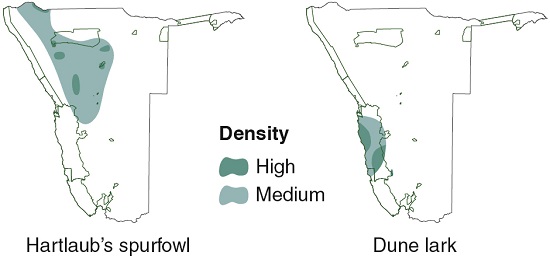
Around 16 species of birds have 90% or more of their global population either entirely within Namibia, or within Namibia and extending into Angola. These species are concentrated in the western half of the country, in the Namib Desert and the belt of mountainous terrain and dry savanna running along the escarpment and immediately inland of it. These areas largely fall within the network of national parks and communal conservancies, where conservation is prioritised.
Hartlaub's spurfowl (Pternistis hartlaubi) is a small francolin found in rocky habitat on the escarpment in northwestern Namibia and southwestern Angola, and farther east towards the Waterberg and the Karstveld around Otavi. The bird is usually found around rocky outcrops and is fairly common within these habitats. Little is known about its ecology. Although the overall low population density and confinement to suitable habitat make this species vulnerable to external influences, it is not classified as threatened.
The dune lark (Calendulauda erythrochlamys) is Namibia's only truly endemic species, with its entire population confined to the dunes of the central Namib. Larks are successful in arid habitats if they are nomadic to some extent, gathering where there is abundant food after rain. Dune larks, however, spend their entire life in the sand dunes, move around very little and make the most of the little shade that is available. Their food of dry seeds is supplemented with insects such as ants and termites, which provide them with sufficient moisture and energy. Such strategies help dune larks live with the extreme heat and aridity of the Namib Desert, where few other bird species can survive.37

Photo: R Knight
Hartlaub's spurfowl
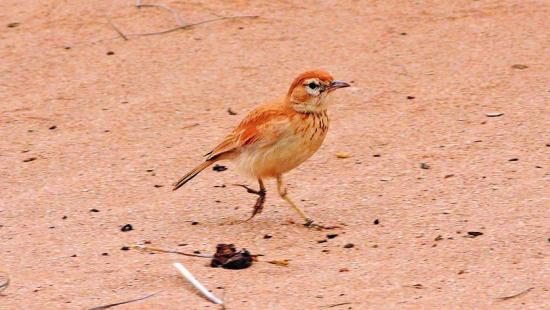
Photo: R Knight
Dune lark
7.23 Reptile endemism38

Reptile endemism is highest in western Namibia (21 species) partly due to the higher diversity of restricted-range species along the escarpment. Of the 65 endemic species, a third (23 species) are thicktoed geckos (genus Pachydactylus). ). There are several highly localised endemics scattered throughout the Namibian interior and these are generally of greatest conservation concern due to their small distributions, although many are not currently listed as threatened. These localised endemics are often associated with specific substrates or geological features. The escarpment, Karas Mountains, Otavi Mountains and the Namib Desert contain important habitats for localised endemics. Several Namibian endemics were only recently described, and more doubtless await recognition.
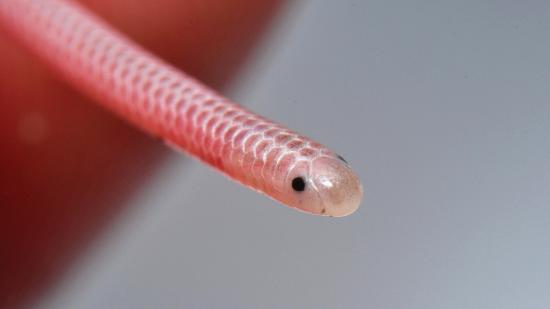
Photo: F Becker
The family of thread snakes (Leptotyphlopidae) contains the smallest snakes in the world, and several species occur in Namibia. They are relatively common but rarely seen because of their subterranean habits, only coming to the surface at night or during rainy conditions. This young Damara thread snake (Namibiana labialis) is barely a millimetre in body diameter.
7.24 Amphibian endemism39
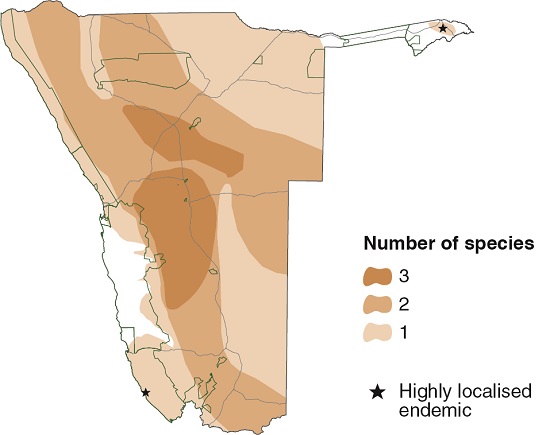
Amphibian endemism is highest in central Namibia, in contrast to their diversity which is greatest in the northeast (figure 7.12). Only five species are considered endemic, and three of these are widespread within Namibia. Two species have highly localised distributions and are of greatest conservation concern: the Mapacha grass frog (Ptychadena mapacha), which only occurs in a small patch of the Zambezi Region; and the desert rain frog (Breviceps macrops) which occurs in the coastal southern Namib Desert, and also extends into South Africa.

Photo: F Becker
Rain frogs do not breed in water, but build underground nests where the eggs are laid. The tadpoles whip up the egg jelly into a foam with antimicrobial properties, and probably use their tails for oxygen exchange. The desert rain frog (Breviceps macrops) occurs only along the coast in the southern Namib Desert, in the fog zone.
7.25 Invertebrate endemism40

This map illustrates the probable, general trends of invertebrate endemism. Endemism rates are relatively low in the northeast because the savanna and woodland habitats there extend over vast areas into neighbouring countries. Conversely, endemism rates in the south and west are particularly high, reflecting the arid adaptations of the fauna and the biogeographic history of the region. The Karas Mountains form an endemic hotspot, as is the escarpment in the west, and the winter-rainfall Succulent Karoo Biome in the far southwest. The highest invertebrate endemism rates in Namibia are found in the Namib Desert; in parts of the Central Namib more than 75 per cent of the species found there occur nowhere else in the world.
7.26 Scorpion endemism41
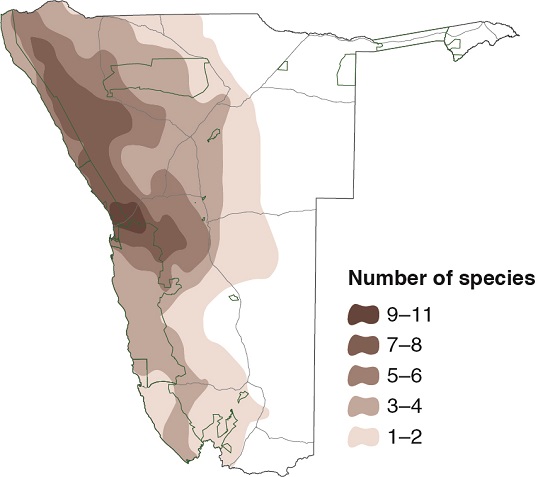
Many species of scorpion are adapted to arid areas, and this is where most of the 14 species of endemics occur. The highest diversity occurs in the western areas where there is a range of rocky and sandy habitats and a mix of elevations. By contrast, there are fewer endemic species in the eastern half of the country and in the Namib dunes where there is less variety in the substrate and topography.
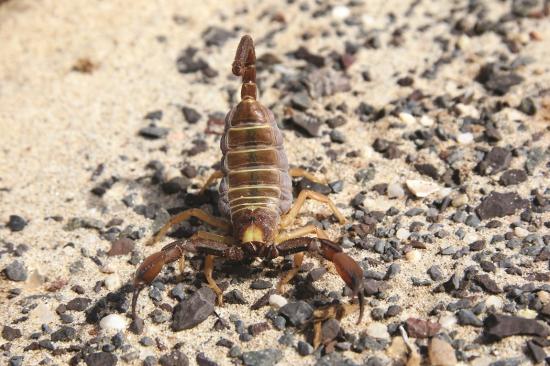
Photo: T Bird
Opistophthalmus litoralis, an endemic burrowing scorpion

